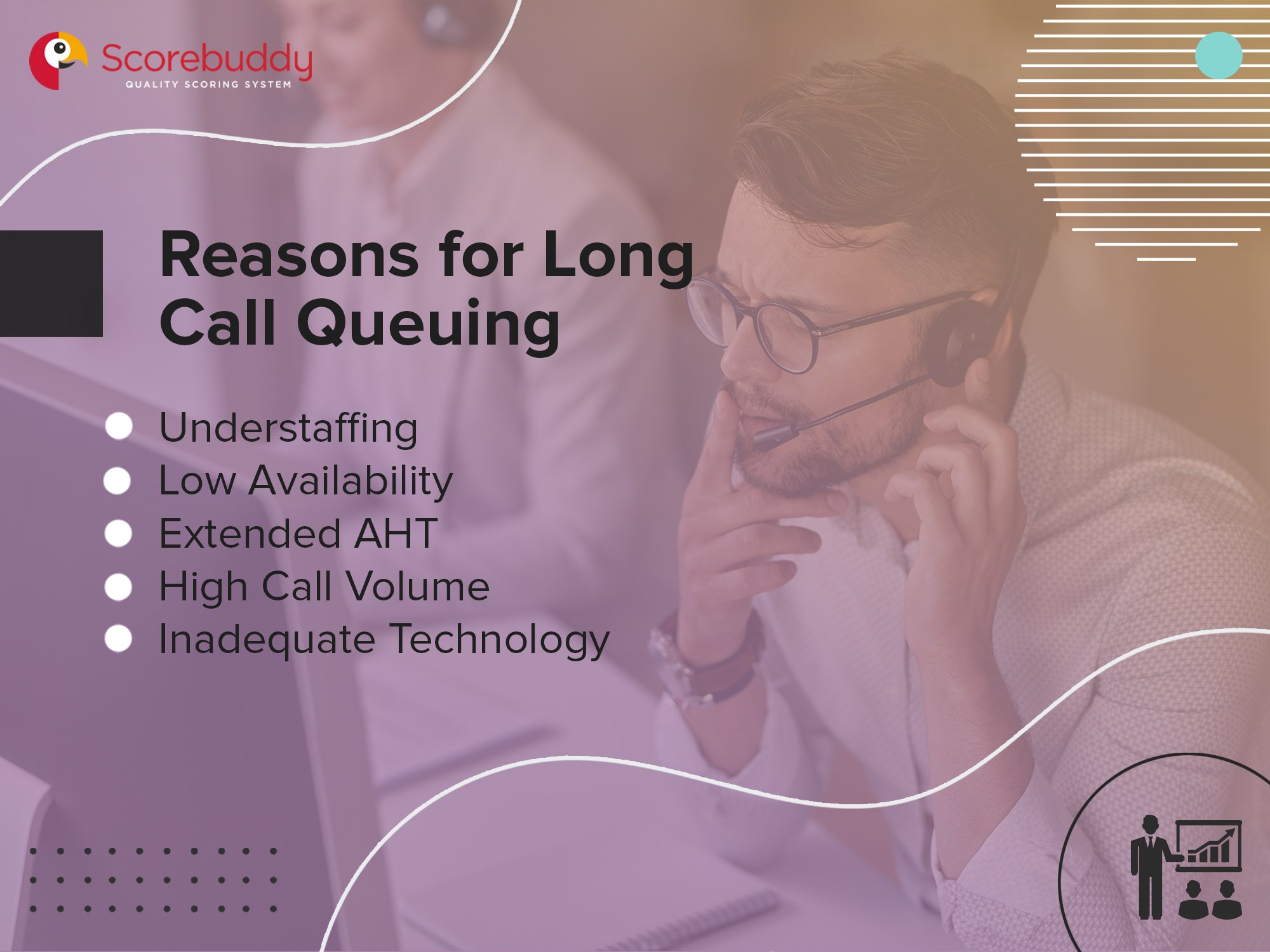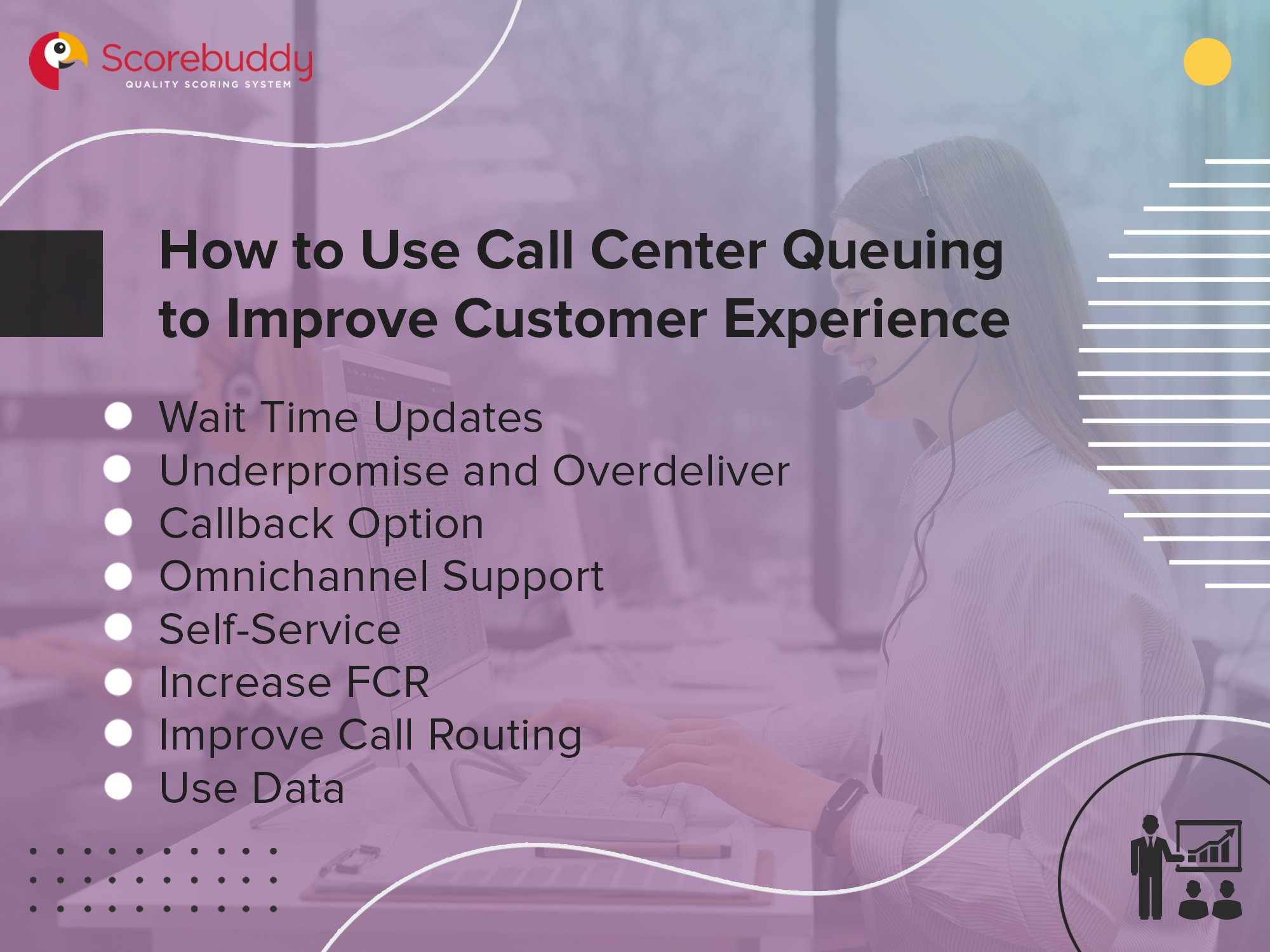Nobody likes to be stuck in a queue. Unfortunately, it happens all too often in a high-volume call center environment.
While this is frustrating for customers and stressful for agents, if you manage it correctly, you can use queuing to improve the customer experience.
In 2022, the average speed of answer (ASA), or the average time in queue was 56 seconds—a 10-second increase on the previous year.
By following our guidelines below, you can use this wait time wisely and turn call center queuing into a platform for understanding and addressing customer pain points.
Call centers use queuing to manage the number of customers trying to contact them so they can cut down on wait times. Typically, contact centers use an automatic call distributor (ACD) to send incoming calls to agents, while an automated voice reassures callers that they will be connected shortly.
Virtual queueing is also a common feature in the modern contact center. With virtual queuing, callers remain in line to speak to an agent without having to stay on the phone. They are placed on a list of “waiting” customers and an agent calls them back later.
While some queuing is inevitable in the call center industry, unusually long queues can indicate underlying issues within the organization.
Here are some of the main reasons for long queue times in contact centers.
If you don’t have enough agents, it will be difficult to handle a high volume of incoming calls, resulting in weak customer experience and stressed agents. A lack of agents will be particularly noticeable during peak times.
Simply having enough staff doesn’t always result in low queuing times. If your agents have too much on their plate or they’re held back by inefficient processes, wait times may increase. Poor scheduling, multiple employees on annual leave, and excessive admin tasks can all limit availability and drive up queue times.
Data from Call Centre Helper finds that average AHT across industries is six minutes and three seconds. If you go beyond this, queue times will escalate, and customers will grow frustrated. Excessive call handling time can result from things like poor agent training, inadequate skill sets, or a lack of effective call routing processes.
More incoming calls inevitably result in more customers in the queue and, as a result, longer waiting times. At peak times, this becomes an even bigger issue, so make sure you look at past data to prepare for any seasonal jumps in call volume.
Technology is an integral part of modern call centers. Without the right tools, it becomes difficult to manage queues effectively. Things like chatbots, IVR, and CRM integrations allow leaders to cut down queue times and help agents find quick resolutions.

Excessive call center queuing can have far-reaching impacts across the entire organization, affecting everything from agent morale and customer satisfaction to operational success and business outcomes.
With 86 percent of customers ready to leave a brand after just two negative experiences, anything that impacts CX can be costly for your contact center. Nobody likes to be kept waiting and excessive queue times can lead to abandoned calls and angry interactions, negatively impacting the overall customer experience.
It’s not just customers that feel the negative impacts of lengthy queue times, agents are affected too. Poor management of incoming calls can overwhelm agents, leading to stress and even burnout, significantly damaging morale across the team and limiting your organization’s productivity.
KPIs are a means of measuring a call center’s performance in specific areas. They are also used by executive level leaders to evaluate the performance of managers and supervisors. Lengthy queue times inevitably damage customer-centric KPIs like CSAT, NPS, average abandonment rate, and more.
As well as dragging down KPIs, lengthy queue times can limit overall business growth and revenue generation. When customers can’t get through to speak to an agent, they may hang up and not call back. This means fewer customers are served, which means fewer opportunities for selling and, potentially, missed deals.
Increasing the number of agents in your call center may seem like the obvious solution to cut down on queueing times, but this approach is expensive and unsustainable. Thankfully, there are plenty of other ways to reduce wait times and improve customer experience. Let’s look at some of them.
The more clarity you can offer, the better. Don’t deliver the generic “Your call is important to us…” message. Be specific and tell the caller that they are number second in the queue, or their estimated wait time is five minutes.
Uncertainty about wait times can be frustrating and anxiety-inducing, severely weakening the customer experience. By taking a proactive approach and regularly providing wait time updates, you can put callers at ease.
IVR technology can be used to inform customers about excessive wait times, preventing queue overflow. Software like Microsoft Teams, for example, displays the agent’s status while callers wait.
We’ve all heard the phrase “underpromise and overdeliver.” It applies to call center queuing as well. If you are handling a large volume of incoming calls, it’s important to be realistic, or even pessimistic, about how soon the customer will be connected to an agent.
Imagine you’re told that an agent will connect with you in two minutes when, in reality, it ends up being ten. This approach will only upset customers and increase the call abandonment rate. It’s better to give yourself breathing room with a pessimistic estimate.
This also helps to manage contact center morale as agents aren’t under excess time pressure on top of their existing workload.
The inclusion of a callback option allows customers to remain in the queue without having to stay on the phone. You connect with the contact center, take your place in the “queue”, and go about your day without waiting on the phone.
By placing callers in a virtual queue, you can assure customers that they will be connected to an agent eventually without wasting their valuable time by keeping them on the line. This puts customers in a better mood ahead of the actual interaction, improving CX.
A common callback approach involves placing callers in the virtual queue only when queue time exceeds a predefined limit. For example, you probably wouldn’t waste time with a virtual queue if there were only two customers waiting, but when the backlog starts to build up, it’s better to employ the callback option.
Modern customers expect an omnichannel experience, with nearly three-quarters agreeing that the ability to switch channels mid-interaction is important. Whether it’s a phone, email, live chat, or any other channel, customers crave convenience and fluidity.

Customers want real-time support and quick resolutions—self-service tools like chatbots, FAQs, knowledge bases, and explainer videos offer both.
Chatbots are a popular option as they can offer interaction and fast resolutions without the need for a human agent. Indeed, estimates suggest that chatbots will be the primary customer service channel for a quarter of organizations by 2027.
In particular, self-service reduces the number of customers entering the call queue with simple queries. This frees up agents to focus on those customers with more complex issues that require involvement, enhancing the customer experience while reducing wait times.
Nobody wants to call multiple times about the same issue, so increasing your FCR is essential. In fact, customers are 2.4x more likely to remain with a brand that solves their problems quickly.
In terms of call queuing, strong FCR performance is beneficial as it reduces the number of repeat calls which, in turn, reduces the overall volume of calls entering the queue. Quick resolutions allow contact centers to handle higher call volumes and contribute directly to customer satisfaction.
Excess repeat calls mean unhappy customers and stressed agents, two surefire ways to drag down your organization’s customer experience.
Effective management of your call queue depends significantly on your call routing system. Using tools like an automatic call distributor (ACD) and interactive voice response (IVR), you can improve FCR, decrease wait times, and minimize the number of transfers.
With 80 percent of customers expecting quick responses to their queries, an effective call routing system is essential to maintaining a high standard of customer experience and consistently delivering strong CSAT scores.
Remember that an effective call routing system doesn’t just direct incoming calls arbitrarily—it directs them according to predefined logic, ensuring that customers are connected to the most suitable agents.
Contact centers process a huge amount of data every day. By gathering data from agent-customer interactions and using it effectively, you can develop an understanding of where your call queuing process is lacking and what changes you could make to enhance it.
Your abandonment rate, in particular, is a key indicator of how callers feel about the queuing process in your call center. With the average abandonment rate last year sitting at 34 percent, anything higher could suggest that your customers are frustrated by the process.
Other KPIs like average time in queue, service level, and average speed to answer can give insights into how agent performance is impacting queue times. By measuring these call center metrics and setting clear targets, you can reduce wait times and improve CX.

Sitting in a queue can be a frustrating experience and, unfortunately, a common occurrence for those contacting a call center. While some queuing is inevitable, excessive wait times can be stressful for both agents and customers.
Thankfully, through effective queue management and the implementation of callback options, omnichannel support, self-service, and more, you can not only reduce call queuing but use it as an opportunity to improve customer experience.
Using a purpose-built QA platform like Scorebuddy, you can monitor agent performance and deliver targeted call center training that leads to better response times, a higher rate of first call resolution, and a lower average handling time—all of which contribute to stronger CX.
To see how Scorebuddy can boost your contact center’s CX—request your free 14-day trial now.